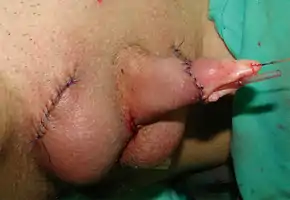Sex reassignment surgery (female-to-male)
Sex reassignment surgery for female-to-male transgender people includes a variety of surgical procedures that alter anatomical traits to provide physical traits more comfortable to the trans man's male identity and functioning. Non-binary people assigned female at birth may also have these surgeries.
| Part of a series on |
| Transgender topics |
|---|
|
|
Often used to refer to phalloplasty, metoidoplasty, or vaginectomy, sex reassignment surgery can also more broadly refer to many procedures an individual may have, such as male chest reconstruction, hysterectomy, or oophorectomy.
Sex reassignment surgery is usually preceded by beginning hormone treatment with testosterone.
Male chest reconstruction
Also called "top surgery", male chest reconstruction is any of a variety of surgeries to remove breast tissue, and provide shaping of a male contoured chest. Surgeries for female-to-male transgender patients have similarities to both gynecomastia surgeries for cisgender men, breast reduction surgery for gigantomastia, and the separate mastectomies done for breast cancer.
Moderate to large breasts usually require a double incision procedure, with grafting and reconstruction of the nipple-areola. This procedure makes it easier to contour the chest and place the nipples in a more natural position but results in more visible scarring.
For smaller breasts, a peri-areolar, or keyhole procedure may be done where the breast tissue is removed through an incision made around the areola. This results in less visible scarring but may result in lower than average nipple placement, and a less natural contour.
There is less denervation of the chest wall with a peri-areolar mastectomy, and less time is required for sensation to return. Loss of sensation to varying degrees is a risk with any chest reconstruction procedure.
Hysterectomy and bilateral salpingo-oophorectomy
Hysterectomy is the removal of the uterus. Bilateral salpingo-oophorectomy (BSO) is the removal of both ovaries and fallopian tubes. A 'partial hysterectomy' is when the uterus is removed, but the cervix is left intact. If the cervix is also removed, it is called a 'total hysterectomy.'
Some trans men desire to have a hysterectomy/BSO because of a discomfort with having them, or when menses fail to fully stop with testosterone replacement therapy.
Hysterectomy/BSO is also done to decrease the risk of developing cervical, endometrial, and ovarian cancer, although it is unknown whether the risk of ovarian cancer is increased, decreased, or unchanged in the transgender male population.
After hysterectomy/BSO, trans men should still see a gynecologist for a check-up at least every three years. This is particularly the case for trans men who:
- retain their vagina (whether before or after further genital reconstruction,)
- have a strong family history of cancers of the breast, ovary, or uterus (endometrium,)
- have a personal history of gynecological cancer or significant dysplasia on a Pap smear.
One important consideration is that any trans man who develops vaginal bleeding after successfully ceasing menses on testosterone must be evaluated by a gynecologist. This is equivalent to postmenopausal bleeding in a woman and may herald the development of gynecologic cancer.
Genital reassignment

Also known as Genital reconstructive procedures (GRT) [1]
Phalloplasty

Phalloplasty is the process of constructing a neopenis using a flap (graft) from the patient's arm, thigh, abdomen, or back.[2] Compared to Metoidioplasty, Phalloplasty provides a larger penis with a more satisfying cosmetic appearance, however, it's more expensive, and many times the penis lacks the ability to achieve an erection.[3] Therefore, many tend to use penile implants to improve erection and get more satisfying cosmetic results.[2] Sexual sensation is usually preserved to the base of the penis, where the original clitoris was.
Metoidioplasty

Metoidioplasty is done after enlarging the clitoris using hormone replacement therapy, where a neopenis is constructed from the enlarged clitoris, with or without extending the urethra to allow urination while standing up. The labia majora are united to form a scrotum, where prosthetic testicles can be inserted. The new neophallus ranges in size from 4–10 cm (with an average of 5.7 cm) and has the approximate girth of a human adult thumb.[4] Sexual sensation and erectile function are usually completely preserved. Specialized metoidioplasty penile implants may be an option in those who cannot achieve penetration during sex.
Penile Implants
Penile implants are usually used in phalloplasty surgery due to the inability of the neophallus to achieve proper erection. The penile implants are used in cisgender men to treat erectile dysfunction, and in transgender men during female-to-male sex reassignment surgery. Although the same penile implant has been used for both cisgender and transgender men, specialized penile implants for transgender men were recently developed by Zephyr Surgical Implants (Switzerland), in both inflatable and malleable models.[5] During phalloplasty, the tissue flap used to build the neophallus is wrapped around the implant either in the same surgery, or in separate surgeries. Penile implants are less commonly used in mitoidioplasty.
See also
- Scrotoplasty
- List of transgender-related topics
- Sex reassignment surgery (male-to-female)
- Penile Implant
Notes and references
- Frey, Jordan D.; Poudrier, Grace; Chiodo, Michael V.; Hazen, Alexes (March 2017). "An Update on Genital Reconstruction Options for the Female-to-Male Transgender Patient: A Review of the Literature". Plastic and Reconstructive Surgery. 139 (3): 728–737. doi:10.1097/PRS.0000000000003062. ISSN 1529-4242. PMID 28234856.
- Kang, Audry; Aizen, Joshua M.; Cohen, Andrew J.; Bales, Gregory T.; Pariser, Joseph J. (June 2019). "Techniques and considerations of prosthetic surgery after phalloplasty in the transgender male". Translational Andrology and Urology. 8 (3): 273–282. doi:10.21037/tau.2019.06.02. PMC 6626310. PMID 31380234.
- "Metoidioplasty: Surgery, Results, and Recovery". Healthline. Retrieved 2020-06-22.
- Metoidioplasty as a Single Stage Sex Reassignment Surgery in Female Transsexuals: Belgrade Experience Djordjevic, Miroslav L. et al., Journal of Sexual Medicine, Volume 6, Issue 5, 1306 - 1313
- Pigot, Garry L. S.; Sigurjónsson, Hannes; Ronkes, Brechje; Al-Tamimi, Muhammed; van der Sluis, Wouter B. (January 2020). "Surgical Experience and Outcomes of Implantation of the ZSI 100 FtM Malleable Penile Implant in Transgender Men After Phalloplasty". The Journal of Sexual Medicine. 17 (1): 152–158. doi:10.1016/j.jsxm.2019.09.019. ISSN 1743-6109. PMID 31680006.
Sources
- Factors Which Influence Individual's Decisions When Considering Female-To-Male Genital Reconstructive Surgery by Katherine Rachlin from the International Journal of Transgenderism. Female-To-Male Genital Reconstructive Surgery. Factors, Benefits and Risks by Dr Preecha Tiewtranon This article also discusses some general issues of female-to-male GRT.